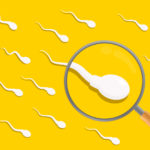About Fertility
Does the Location for Semen Collection Impact Outcomes?

A semen analysis, also known as a sperm count test, is a laboratory examination of a man’s semen to assess the quantity, quality, and overall health of the sperm. The analysis provides valuable information about fertility potential and can help diagnose potential causes of infertility. Does the location for semen collection impact outcomes?
Historically, fertility clinics preferred on-site collection of semen samples over home collection. During the COVID-19 pandemic, there was a massive shift to home collection in order to prioritize patient safety and limit the spread of disease. As we emerge from this pandemic, it is important to understand whether any outcome differences exist between home collection versus on-site collection.
A recent meta-analysis looked at several different measures to try to answer this question. They found that home collection had essentially no impact on semen parameters, fertilization rates, or pregnancy rates with in vitro fertilization.
Over time, more research is necessary as clinics continue to shift to home collection. These preliminary results are encouraging, however, as they suggest that home collection is a safe, reasonable alternative to onsite semen collection for patients who live within a reasonable distance of their fertility clinic.
How Does a Semen Analysis Work?
Producing a sample in a time-sensitive and unfamiliar setting can be anxiety provoking. However, it is essential to the evaluation process that the sample be produced no more than one hour before analysis. For this reason, the Fertility Centers of New England provides private, clean, and comfortable rooms for sperm production. Sometimes, your doctor may allow the sample to be produced off-site as long as it can be transported warm to the lab within an hour so that the sample then can be assessed in a timely manner.
Here’s a general overview of how a semen analysis is typically done:
1. Collection: The sample is usually collected by masturbation into a sterile container provided by the laboratory. It’s important to follow the specific instructions given by the laboratory for sample collection.
2. Abstinence: To obtain accurate results, it’s generally recommended to abstain from ejaculation for 2 to 5 days before the test. This ensures that the sample contains an adequate number of sperm.
3. Sample processing: Once the semen sample is collected, it needs to be processed in the laboratory. The process involves liquefying the sample, as semen initially coagulates after ejaculation. Liquefaction is typically achieved by keeping the sample at room temperature for about 30 minutes.
4. Microscopic examination: After liquefaction, a small portion of the semen is placed on a glass slide and covered with a coverslip. The slide is then examined under a microscope by a trained laboratory technician or an andrologist. They assess various parameters, including:
– Sperm count: The number of sperm present in a given volume of semen.
– Sperm motility: The percentage of sperm that are moving and their swimming patterns.
– Sperm morphology: The shape and structure of sperm, particularly the head, midpiece, and tail.
– Sperm vitality: The percentage of live sperm in the sample.
– Other factors: The analysis may also evaluate pH level, volume of semen, liquefaction time, and the presence of white blood cells or other substances that could affect fertility.
5. Additional tests: In some cases, further tests may be performed to investigate specific issues. These tests can include measuring sperm antibodies, DNA fragmentation analysis, or assessing the presence of infections or other abnormalities.
Contact Us
At Fertility Centers of New England, our goal is to optimize all aspects of a patient’s overall health in order to have the best possible chance of conceiving. If you are seeking more information on male fertility or what to expect with a semen analysis, please contact us today!



